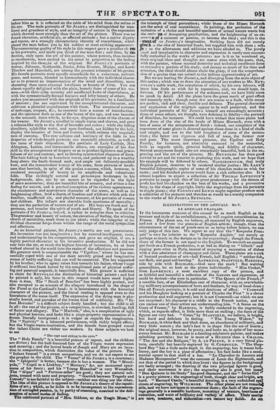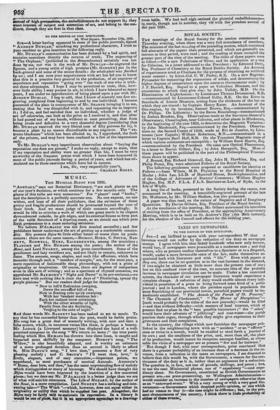ILLUSTRATIONS OF TFIE ANNUALS. No V.
LE KEEPSAKE FILANiAIS.
IF the letterpress contents of this annual be as much English as the manner and style of its embellishments, it will require naturalization in France. The plates are, we believe, all executed by English engravers, and not a few from the pictures of English artists; though, from the circumstance of the set of proofs sent to us being before letters, we cart only judge of this fact. We regret to say that the" Keepsake Fran. cais" is very far inferior to the " Keepsake Anglais," not merely or perhaps so much in the designs as in the engravings ; though the French share of the former is not equal to the English. To see such an annual put forth as a French production, is as bad as dining on 46 bifteck" and sipping port-wine in Paris, instead of enjoying a succession of dishes with a due admixture of champagne and claret. These plates are a sort of bastard production of art—half French, half English; "neither fish, nor flesh, nor good red-herring." LAWRENCE, STANFIELD, HARDING, side by side with ROCHARD,—God save the mark ! But waiving generalities, let us look at the plates individually. "Miss Croker," from LAWRENCE; a most excellent copy of the picture, and as faithful and beautiful a reflection of the features and expression, as could be desired—the eyes in particular. "The Queen of the French ;" a sensible face, of an Elizabethan cast of character, with an overwhelm- ing millinery accompaniment of bows and feathers, by way of head-dress: like all French portraits, it is cold and destitute of effect. "Cromwell and his Daughter looking at a portrait of Charles the First" is a clever production and well engraved; but it is not Cromwell—at which we are not surprised: his character is a riddle to the French nation, and we can excuse one of their artists not understanding him. "A Scene on the Coast of France," by HARDING, is feebly rendered in the engraving, which, as regards effect, is little more than an etching; the faces of the figures are very bad. "Como," by STANFIELD, we believe, is bright, but hard and deficient in feeling. "The Young Widow," by ROCHARD, is white flesh and black dress, an abundance of millinery, and very little nature ; the lady's face is in shape like the ace of hearts; the original must, however, be pretty, and looks so, in spite of her mon.. _ strous bonnet. Mr. ROCHARD is a dazzling miniature-painter, and makes splashing portraits; but he is more of a HUDSON than a CHALON. "The Ass and the Reliques," by A. LE PRINCE, is a very literal pie. ture, carefully but heavily engraved by G. CORBOULD. "The Shep- herd Boy "has a little more depth in the engraving, but it wants bril. Haney, and the boy is a piece of affectation; his face looks like a senti. mental oyster in that shell of a hat. "Le Chevalier de Lauzun and Madame Montpensier" wear the costume of Louis the Eighteenth, and not that of the period in which they lived the figures in the background are badly arranged; the drawing of the two principal figures is good, and their movement is airy; the engraving also is good, but tame: "Don Quixote in his Study" has good character, and the " Swiss Girl " is a pretty picture; the engravings of both, though clear and bright, are hard. " Barnard Castle," a beautiful drawing, is a very unfinished spe) cimen of engraving, by WILLI:TORE. The other plates are not remarts: able, and we have not space to enumerate them; the fault of the engrav. ings generally is a metallic hardness, monotoay, of texture, heaviness of execution, and want of brilliancy and variety of effect. Their merits are care., neatness, and elaboration—we cannot say. finish. As an annual of- high. pretensionar the. embellishments do not support ft.; they *ant interest of subject and attraction of art, and belong to the me- diocre, though they are first in that class. • '



























 Previous page
Previous page